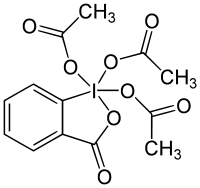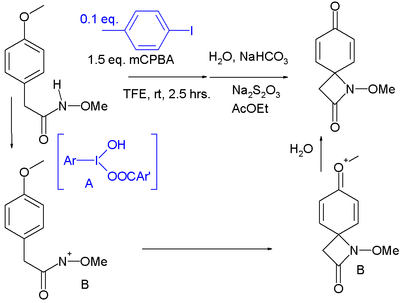Periodinane

Periodinanes are chemical compounds containing hypervalent iodine. These iodine compounds are hypervalent because the iodine atom in it contains more than the 8 electrons in the valence shell required for the octet rule. When iodine is complexed with a monodentate electronegative ligand such as chlorine, iodine compounds occur with a +3 oxidation number as iodine(III) or λ3-iodanes or as a +5 oxidation number as iodine(V) or λ5-iodanes. Iodine itself contains 7 valence electrons and in a λ3-iodane three more are donated by the ligands making it a decet structure. λ5-iodanes are dodecet molecules. In an ordinary iodine compound such as iodobenzene the number of valence electrons is eight as expected. In order to get from iodine to a hypervalent iodine compound it gets oxidized with removal of first 3 electrons and then 5 electrons. The ligands in turn contribute electrons pairs and form coordinate covalent bonds by adding a total of 6 or 10 electrons back to iodine. In the L-I-N notation L stands for the number of electrons donated by ligands and N the number of ligands.
Periodinane compounds
The concept of hypervalent iodine was developed by J.J. Musher in 1969. In order to accommodate the excess of electrons in hypervalent compounds the 3-center-4-electron bond was introduced in analogy with the 3-center-2-electron bond observed in electron deficient compounds. One such bond exists in iodine(III) compounds and two such bonds reside in iodine(V) compounds.
The first hypervalent iodine compound, (dichloroiodo)benzene (C6H5Cl2I) was prepared in 1886 by the German chemist Conrad Willgerodt [1] by passing chlorine gas through iodobenzene in a cooled solution of chloroform.
- C6H5I + Cl2 → C6H5ICl2
λ3-iodanes such as diarylchloroiodanes have a pseudotrigonal bipyramidal geometry displaying apicophilicity with a phenyl group and a chlorine group at the apical positions and other phenyl group with two lone pair electrons in the equatorial positions. The λ5-iodanes such as the Dess-Martin periodinane have square pyramidal geometries with 4 heteroatoms in basal positions and one apical phenyl group.
Classical organic procedures exist for the preparation of iodosobenzene diacetate from peracetic acid and acetic acid.[2]
- C6H5I + CH3COOOH → C6H5I(OOCCH3)2
Phenyliodine bis(trifluoroacetate), PIFA, or (bis(trifluoroacetoxy)iodo)benzene is a related compound based on trifluoroacetic acid
Phenyliodine diacetate, PIDA, is an organic reagent used as an oxidizing agent. This is suitable for cleaving glycols and alpha-hydroxy ketones in ring opening and Mannich reaction.
The acetate can be hydrolysed with water to iodoxybenzene or iodylbenzene C6H5O2I [3]
This compound was first prepared by Willgerodt by disproportionation of iodosylbenzene under steam distillation to iodylbenzene and iodobenzene
- 2 PhIO → PhIO2 + PhI
is a known oxidizing agent. Iodosobenzene diacetate can also be hydrolyzed to iodosylbenzene with sodium hydroxide which is actually a polymer with the molecular formula (C6H5OI)n.[4] Iodosylbenzene is used in organic oxidations. Dess-Martin periodinane (1983) is another powerful oxidant and an improvement of the IBX acid already in existence in 1983. The IBX acid is prepared from 2-iodobenzoic acid and potassium bromate and sulfuric acid [5] and is insoluble in most solvents whereas the Dess-Martin reagent prepared from reaction of the IBX acid with acetic anhydride is very soluble. The oxidation mechanism ordinarily consists of a ligand exchange reaction followed by a reductive elimination.
Diaryliodonium salts
Diaryliodonium salts are compounds of the type [Ar–I+–Ar]X−.[6] The term salt is misleading and IUPAC prefers diaryl-λ3-iodane. The first such compound was synthesised in 1894 (Meyer and Hartmann reaction).[7] With halogen counterions diaryliodonium salts show poor solubility in many organic solvents but solubility is improved with triflate and tetrafluoroborate counterions.
Diaryliodonium salts can be prepared in a number of ways. In one method an aryl iodide is first oxidized to an aryliodine(III) compound (ArIO, ArIO2) with as a second step a ligand exchange with an arene (AES), an arylstannane or an arylsilane. In another method diaryliodonium salts a prepared from preformed hypervalent iodine compounds such as iodic acid, iodosyl sulfate or iodosyl triflate.
diaryliodonium salts react with nucleophiles at iodine replacing one ligand and then form the substituted arene ArNu and iodobenzen ArI by reductive elimination or by substitution by ligand. diaryliodonium salts also react with metals M through ArMX intermediates in cross-coupling reactions.
Periodinane uses
The predominant use of hypervalent iodine compounds is that of oxidizing reagent replacing many toxic reagents based on heavy metals.[8] Thus, a hypervalent iodine (III) reagent was used, as oxidant, together with ammonium acetate, as the nitrogen source, to provide 2-Furonitrile, a pharmaceutical intermediate and potential artificial sweetener, in aqueous acetonitrile at 80 °C in 90% yield.[9]
Current research focuses on their use in carbon-carbon and carbon-heteroatom bond forming reactions. In one study such reaction, an intramolecular C-N coupling of an alkoxyhydroxylamine to its anisole group is accomplished with a catalytic amount of aryliodide in trifluoroethanol:[10]

In this reaction the periodinane (depicted as intermediate A) is formed by oxidation of the aryliodide with the sacrificial catalyst mCPBA which in turn converts the hydroxylamine group to a nitrenium ion B. This ion is the electrophile in ipso addition to the aromatic ring forming a lactam with an enone group.
See Also
References
- ↑ C. Willgerodt, Tageblatt der 58. Vers. deutscher Naturforscher u. Aertzte, Strassburg 1885.
- ↑ J. G. Sharefkin and H. Saltzman. "Benzene, iodoso-, diacetate". Org. Synth.; Coll. Vol. 5, p. 660
- ↑ J. G. Sharefkin and H. Saltzman. "Benzene, iodoxy-". Org. Synth.; Coll. Vol. 5, p. 665
- ↑ H. Saltzman and J. G. Sharefkin. "Benzene, iodoso-". Org. Synth.; Coll. Vol. 5, p. 658
- ↑ Robert K. Boeckman, Jr., Pengcheng Shao, and Joseph J. Mullins. "1,2-Benziodoxol-3(1H)-one, 1,1,1-tris(acetyloxy)-1,1-dihydro-". Org. Synth.; Coll. Vol. 10, p. 696
- ↑ Diaryliodonium Salts: A Journey from Obscurity to Fame Eleanor A. Merritt and Berit Olofsson Angew. Chem. Int. Ed. 2009, 48 doi:10.1002/anie.200904689
- ↑ C. Hartmann, V. Meyer, Ber. Dtsch. Chem. Ges. 1894, 27, 426.
- ↑ Hypervalent iodine(V) reagents in organic synthesis Uladzimir Ladziata and Viktor V. Zhdankin Arkivoc 05-1784CR pp 26-58 2006 Article
- ↑ Chenjie Zhu; Sun, Chengguo; Wei, Yunyang (2010). "Direct oxidative conversion of alcohols, aldehydes and amines into nitriles using hypervalent iodine(III) reagent". Synthesis 24: 4235–4241. doi:10.1055/s-0030-1258281.
- ↑ Dohi, T.; Maruyama, A.; Minamitsuji, Y.; Takenaga, N.; Kita, Y. (2007). "First hypervalent iodine(III)-catalyzed C-N bond forming reaction: catalytic spirocyclization of amides to N-fused spirolactams". Chemical Communications (Royal Society of Chemistry) (12): 1224–1226. doi:10.1039/b616510a. PMID 17356763.